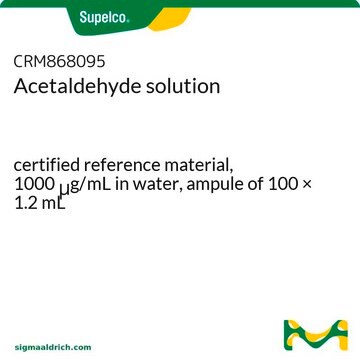719099
Acetaldehyde solution
5 M in THF
About This Item
Produits recommandés
Forme
liquid
Niveau de qualité
Concentration
5 M in THF
Indice de réfraction
n20/D 1.389
Densité
0.868 g/mL at 20 °C
0.843 g/mL at 25 °C
Groupe fonctionnel
aldehyde
Température de stockage
2-8°C
Chaîne SMILES
[H]C(C)=O
InChI
1S/C2H4O/c1-2-3/h2H,1H3
Clé InChI
IKHGUXGNUITLKF-UHFFFAOYSA-N
Vous recherchez des produits similaires ? Visite Guide de comparaison des produits
Catégories apparentées
Mention d'avertissement
Danger
Mentions de danger
Conseils de prudence
Classification des risques
Carc. 1B - Eye Irrit. 2 - Flam. Liq. 2 - Muta. 2 - STOT SE 3
Organes cibles
Central nervous system, Respiratory system
Risques supp
Code de la classe de stockage
3 - Flammable liquids
Classe de danger pour l'eau (WGK)
WGK 3
Point d'éclair (°F)
-25.1 °F - closed cup
Point d'éclair (°C)
-31.7 °C - closed cup
Faites votre choix parmi les versions les plus récentes :
Déjà en possession de ce produit ?
Retrouvez la documentation relative aux produits que vous avez récemment achetés dans la Bibliothèque de documents.
Les clients ont également consulté
Notre équipe de scientifiques dispose d'une expérience dans tous les secteurs de la recherche, notamment en sciences de la vie, science des matériaux, synthèse chimique, chromatographie, analyse et dans de nombreux autres domaines..
Contacter notre Service technique






